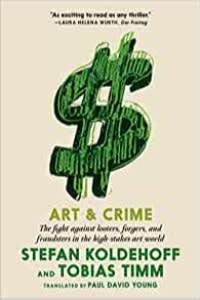Art and Crime – terrifying stories of thieves, forgers and fraudsters
Money laundering, tax evasion, smuggling, looting of cultural sites, counterfeiting, Nazi theft and looting are just some of the activities you might encounter in a world that likes to present itself as the height of refined sensibility and cultural expression: the art market.
So write Stefan Koldehoff and Tobias Timm, two investigative journalists from Germany, who have covered the dark side of the art industry for more than a decade in publications such as Die Zeit and art-Das Kunstmagazin.
It is certainly rich territory. The FBI estimates that crimes against artistic and cultural property result in the loss of billions of dollars every year. It’s also worth wondering if things are getting worse, as prices reach stratospheric levels (almost half a billion dollars in the case of Leonardo da Vinci’s “Salvator Mundi” when it was auctioned four years ago) in an increasingly globalized market.
Although the authors do not answer this question directly, the stories they tell in art and crime make the hair stand up. Some are well known and date back decades; others are more recent and involve leading international figures.
Since art is now seen as a financial asset, a store of value and an investment that few other assets can match, understanding the darker side of the market is essential. This also applies to what happened in the past as to how art is used today for all kinds of nefarious purposes.
Take Modigliani’s problematic legacy, with its parade of competing pundits, some of whom certified fakes or even included them in their publications. Entire exhibitions of Modigliani’s work in Spain, Germany and Italy were confiscated by the police as stuffed with forgeries. During this time, the Parisian curator Marc Restellini and the Wildenstein-Plattner Institute remain locked in a legal battle ostensibly to establish control over the lucrative authentication business of his work.
The authors also waded into the long-standing and deeply problematic world of antiquities, from the case of curator Marion True and her 1980s purchases for the Getty Museum of illicitly exported ancient artifacts, to to today’s murky ‘grey market’. . Some of the antiquities peddled today have been illegally looted from Iraq and Syria, ravaged by conflict, and potentially used to fund terrorism; others are blatant counterfeits; and still others without provenance but not necessarily looted.
closer to home, art and crime offers fascinating details about the case of the German artistic adviser Helge Achenbach, which defrauded collectors of tens of millions of euros, including Aldi heir Berthold Albrecht and Christian Boehringer of pharmaceutical company Boehringer Ingelheim. Beginning in the 1970s, the authors write, “art became a status symbol for big business and their leaders.” And modern art was described with adjectives that resonated with the business world: “dynamic, open, creative, innovative, courageous and resolute”.
A tireless self-promoter and shrewd operator, Achenbach sold works by Pablo Picasso, Oskar Kokoschka, Gerhard Richter, Jörg Immendorff and Günther Uecker to a range of corporate clients, while changing bills to massively increase his cut. It all came to a halt when in 2015 Achenbach was found guilty of fraud and embezzlement and sentenced to six years in prison.
Imelda Marcos, who together with her husband Ferdinand built up a collection including a $3.5 million “Michelangelo”
“When Dictators Gather” is the title of a chapter delving into the misdeeds of Ferdinand and Imelda Marcos. The former first couple of the Philippines have amassed an impressive art collection by plundering the country’s wealth. It ranged from old masters, including a $3.5 million “Michelangelo,” to more modern works such as a $35 million Monet. Today, more than 100 works worth more than $24 million are still missing, despite the strenuous efforts of prosecutors.
Then there were Donald Trump’s attempts to increase the value of a portrait of himself at auction – and the $2 million in damages a New York judge ordered. ordered the former US president to pay for misusing charitable assets. Or the problematic subject of a collection of 1,800 Russian avant-garde paintings which is apparently offered for sale around London, despite a court in Wiesbaden finding 19 works by the group to have been tampered with.
The task of criminals is greatly facilitated by the incompetence or complacency of those responsible for guarding the works of art, write the authors. Some museums turn a blind eye to fragile provenances; others prove unable to provide basic security, as in the case of the 2017 flight of a pure gold coin weighing 220 pounds from the Bode Museum in Berlin.
For reasons possibly related to the German legal system, art and crime avoids naming many of those he cites, giving only first names and initials. It seems unnecessary since most can be found immediately on the Internet. The book is not particularly well written, perhaps because of this reviewer reading the translation, and is a little confusing at times.
Despite the litany of wrongdoings they recount, the authors write, “The overwhelming majority of art dealers conduct themselves properly.” And all is not lost. At the end, Koldehoff and Timm propose 10 simple questions (among which, what is the source? Is the price too low? What is the identity of the seller?) that all professionals should ask themselves before any transaction, and they dare even such questions could lead to stories that could enhance the value of a work of art.
Optimistic? Maybe, but it would certainly help protect the industry from the thieves, forgers, and scammers that Koldehoff and Timm chronicle so effectively.
Art and crime: The fight against looters, forgers and fraudsters in the high-stakes art world by Stefan Koldehoff and Tobias Timm (translated by Paul David Young) Seven Stories Press, £20, 416 pages
Join our online book group on Facebook at FT Books Coffee
